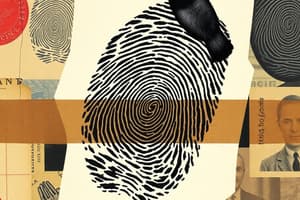Podcast
Questions and Answers
What does forensic science primarily use to aid legal proceedings?
What does forensic science primarily use to aid legal proceedings?
- Scientific methods (correct)
- Artistic representations
- Mathematical computations
- Psychological assessments
What is the main role of a criminalist specializing in DNA analysis?
What is the main role of a criminalist specializing in DNA analysis?
- To evaluate witness statements
- To interrogate suspects
- To analyze biological materials for DNA (correct)
- To analyze financial records
Which statement best describes the CSI effect?
Which statement best describes the CSI effect?
- The positive impact of crime shows on juror understanding
- The enhancement of courtroom techniques because of popular media
- The public's unrealistic expectations of forensic science based on TV dramas (correct)
- The decrease in crime rates due to forensic advancements
What distinguishes civil court from criminal court?
What distinguishes civil court from criminal court?
What is a fundamental qualification for someone to be considered an expert witness?
What is a fundamental qualification for someone to be considered an expert witness?
What is a major challenge faced by crime laboratories?
What is a major challenge faced by crime laboratories?
Which of the following best defines 'criminalistics'?
Which of the following best defines 'criminalistics'?
What educational background is typical for a crime lab worker?
What educational background is typical for a crime lab worker?
What does the term 'manner of death' refer to?
What does the term 'manner of death' refer to?
Which of the following best describes rigor mortis?
Which of the following best describes rigor mortis?
What is the significance of livor mortis in a death investigation?
What is the significance of livor mortis in a death investigation?
What is the primary purpose of analyzing stomach contents during an autopsy?
What is the primary purpose of analyzing stomach contents during an autopsy?
Which of the following statements about the Locard Exchange principle is true?
Which of the following statements about the Locard Exchange principle is true?
In forensic terms, what does persistence refer to?
In forensic terms, what does persistence refer to?
What is the distinction between known evidence and questioned evidence?
What is the distinction between known evidence and questioned evidence?
What is an example of real evidence?
What is an example of real evidence?
What does rigor mortis typically indicate about the timing of death?
What does rigor mortis typically indicate about the timing of death?
Which type of error is a false positive in forensic testing?
Which type of error is a false positive in forensic testing?
What is the primary role of Bloodstain Pattern Analysis (BPA) in crime scene investigations?
What is the primary role of Bloodstain Pattern Analysis (BPA) in crime scene investigations?
How does algor mortis assist in determining the time of death?
How does algor mortis assist in determining the time of death?
Which of the following correctly describes putrefaction?
Which of the following correctly describes putrefaction?
What is a key factor affecting the transfer of evidence?
What is a key factor affecting the transfer of evidence?
Flashcards
Forensic Science
Forensic Science
Using scientific methods to solve legal issues.
Criminalistics
Criminalistics
The science of individualizing evidence from a crime scene.
CSI effect
CSI effect
Public's unrealistic expectations of forensic science, often seen in TV shows.
Expert Witness
Expert Witness
Signup and view all the flashcards
DNA Analyst
DNA Analyst
Signup and view all the flashcards
Toxicologist
Toxicologist
Signup and view all the flashcards
Trace Analyst
Trace Analyst
Signup and view all the flashcards
Firearms Analyst
Firearms Analyst
Signup and view all the flashcards
Locard Exchange Principle
Locard Exchange Principle
Signup and view all the flashcards
Forensic Diamond
Forensic Diamond
Signup and view all the flashcards
Manner of Death
Manner of Death
Signup and view all the flashcards
Cause of Death
Cause of Death
Signup and view all the flashcards
Rigor Mortis
Rigor Mortis
Signup and view all the flashcards
Livor Mortis
Livor Mortis
Signup and view all the flashcards
Algor Mortis
Algor Mortis
Signup and view all the flashcards
Autolysis
Autolysis
Signup and view all the flashcards
Putrefaction
Putrefaction
Signup and view all the flashcards
Real Evidence
Real Evidence
Signup and view all the flashcards
Demonstrated Evidence
Demonstrated Evidence
Signup and view all the flashcards
Known Evidence
Known Evidence
Signup and view all the flashcards
Questioned Evidence
Questioned Evidence
Signup and view all the flashcards
Type 1 Error
Type 1 Error
Signup and view all the flashcards
Type 2 Error
Type 2 Error
Signup and view all the flashcards
Study Notes
Forensic Science Overview
- Forensic Science: Science used in a court of law/justice system
- Criminalistics: Science of individualization; analyzes and interprets crime scene evidence, reconstructs the crime
- CSI Effect: Public perception of unrealistic standards in the legal system due to TV portrayals
- Penny Parker Case: Solved using DNA profiling; partial DNA match to suspect's daughter, ultimately confirmed by suspect's sample
Court Systems
- Civil Court: Aims to assign fault and determine compensation for civil disputes (approx. likelihood of placing fault: 50%)
- Criminal Court: Deals with law violations, resulting in citations or arrests; defendants face felony or misdemeanor charges
Expert Witness Qualifications
- Demonstrates knowledge of methods and limitations
- Familiar with scientific literature
- Clearly presents the basis of their opinions
- Testifies independently about scientific results
- Accepts scrutiny by opposing counsel (judge's decision)
Crime Lab Careers
- DNA Analyst: Analyzes biological samples (blood, bone, hair, saliva, semen) using databases and statistical analysis.
- Toxicologist: Analyzes blood, urine, and tissue for drugs, narcotics, and alcohol.
- Trace Analyst: Examines paint, hair, fibers, soils, ropes, tape, and explosive residue.
- Firearms Analyst: Analyzes bullets and cartridge cases to determine their origin and reconstruct shootings.
Educational Requirements
- Bachelor's degree in a science is a standard requirement for a crime lab career
Crime Lab Challenges
- Maintaining a consistent standard of evidence handling and evaluation among different labs.
- DNA Analyst: Likely needs more biology- and lab-focused courses.
Solving Crime: Fundamentals
- Forensic Science: Using science to resolve legal disputes
- Criminalistics: Science of individualism
- Locard Exchange Principle: Every contact leaves a trace
- Forensic Diamond: Framework for connecting victim, suspect, crime scene, and evidence
- Evidence Types: Include animal hair, building materials, chemical analysis, powder, liquids, and stains.
Death and Crime Scene Investigation
- Manner of Death: How death occurred (suicide, homicide, natural, accidental, undetermined)
- Cause of Death: The specific injury or disease that caused death (e.g., gunshot wound, heart attack)
- Rigor Mortis: Muscle stiffening after death; timeline is useful.
- Livor Mortis: Blood pooling in the body, indicating if a body was moved.
- Algor Mortis: Body cooling after death, can be helpful with timing.
- Time of Death: Accurate estimations around 12 hours after death.
- Post-Mortem Shutdown: Respiratory, circulatory, central nervous systems cease in that order; cellular metabolism then ends.
- Decomposition Start: Begins internally.
- Stomach Content: Can provide clues about time of death according to digestion level
- Vitreous Potassium: Potassium in the eye fluid may be used as a time indicator after death.
- Autolysis: Body's digestive enzymes breaking down tissues
- Putrefaction: Bacteria and fungi breakdown proteins
- Estimating Time of Death: Environmental details (mail, newspaper, light, etc.), daily habits, and microbiomes help
Evidence in Court
- Evidence: Information used to make a fact more or less likely
- Trier of Fact: Jury or judge, who determines the relevant evidence's importance
- Real Evidence: Found at the crime scene
- Demonstrated Evidence: Added later to explain the crime scene or evidence already found.
- Locard Exchange Principle: Exchange of material when items or people are in contact.
- Evidence Transfer Conditions: Pressure, contact frequency, materials' characteristics affect transfer.
- Evidence Persistence: Transfer remains, persisting until it degrades, transfers again, or is collected
- Classification of Evidence: Identity (physical properties), class (subgroups), individualization (specific only, ex. unique fingerprint)
- Known & Questioned Evidence: Known—defined source; questioned—unknown source
- Controls (Positive & Negative): Positive—expected result; Negative—no result should occur; useful to rule out false positives or negatives.
- Type I & Type II Errors: Type I—false positive; Type II—false negative
Bloodstain Pattern Analysis
- Bloodstain Pattern Analysis (BPA): Provides forensic information about bloodshed events
- BPA Purpose: Determine actions and sequences leading to the bloodstains
- Bloodstain Types: Passive (gravity), spattered (force), altered (further modifications).
Studying That Suits You
Use AI to generate personalized quizzes and flashcards to suit your learning preferences.



